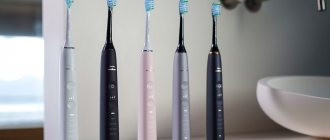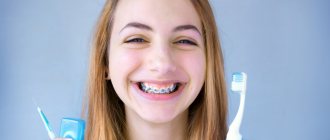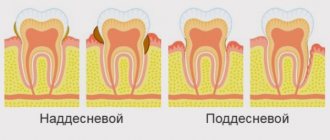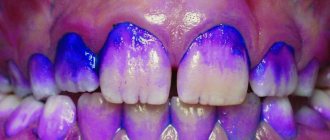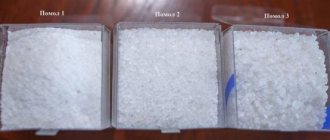From this article you will learn:
- how to properly care for your teeth,
- what is the best way to brush your teeth,
- how to protect teeth from caries.
The development of caries occurs with the participation of cariogenic bacteria in the oral cavity, which metabolize food debris stuck between the teeth after eating, turning them into lactic acid.
The acid dissolves the surface layer of tooth enamel, initially leading to the appearance of white chalky spots, which are the most initial, yet reversible, form of caries. White spots on human teeth are symptoms of the appearance of foci of demineralization of tooth enamel, in which acid has dissolved a significant part of the minerals (hydroxyapatite). If the acid attack continues for a long time, then the demineralization process reaches such a degree that the density of the enamel not only decreases, but its structural destruction occurs - a carious tooth defect is formed. The latter can be cured only by filling the tooth.
Thus, the main role in the development of caries is played by 1) microbial plaque, 2) food debris. Good regular oral hygiene can remove both of these components from teeth, but it is also important to avoid constant snacking between meals and frequent consumption of sugar-sweetened drinks. Therefore, if you are asking yourself how to get rid of tooth decay, then proper regular oral hygiene is the most important part of protecting your teeth from tooth decay and gum disease. And below we will tell you what it should be.
Important: dental care may include not only regular teeth brushing, but also additional measures that will help you strengthen your tooth enamel even more effectively. For example, the risk of developing caries can be further reduced by remineralizing teeth (we are talking about professional and home fluoridation of teeth). And we will also talk about all this in detail below.
Will floss prevent dental caries?
A recent New York Times article[] questioned the benefits of dental floss.
A 2011 study[] found that flossing in addition to brushing reduces the risk of gum disease. And not too much, since most people don’t floss their teeth thoroughly enough.
But in the fight against enamel destruction, thread is not a help at all. There is still no evidence that regular flossing reduces the risk of tooth decay.
Reasons for appearance
The development of caries occurs when bacteria penetrate into the tooth or when they are exposed to tooth enamel for a long time. The main reason for the appearance of pathology is poor oral hygiene. Insufficiently thorough cleansing of the oral cavity from plaque, which accumulates daily, leads to its accumulation and the appearance of deposits. Bacteria “corrode” tooth enamel, penetrate into subgingival pockets and microcracks, provoking the development of an infectious process.
In addition to poor dental hygiene, other factors can cause tooth decay.
General factors.
- Deficiency of vitamins and minerals.
- Diseases of the immune system.
- Hormonal disorders.
- Diabetes.
- Effect of high or low temperatures.
- Heredity.
Local factors.
- Contains a large amount of acid in saliva.
- Weakened enamel.
- Pulp and periodontal pathologies.
- Malocclusion.
- Deviations in teething.
- Congenital anomalies of the dental system.
- Anomaly in the biochemical composition of dental bone tissue.
Excessive consumption of sweets is often attributed to the causes of tooth decay. In fact, the sugar contained in such foods does not have any negative effects if the teeth are healthy and properly cared for. Sweets that cause active production of saliva with high acidity, of course, cause caries, but only in combination with other provoking local factors.
Do I need a dental scan?
American dentists recommend having your teeth x-rayed every year. Austin Frakt, a health economist, reviewed[] medical studies and concluded that such reinsurance is unwarranted. Cavities in the tooth form more slowly—over 2–3 years.
In Russia, preventive x-rays are not so popular. But computed tomography is suggested to be done regularly. You should also not agree to this expensive service more often than once every couple of years.
Consequences
Untimely treatment of caries can lead not only to dental disease, but also to other disorders of the body:
- disorders in the immune system caused by bacteria and leading to frequent acute respiratory viral infections;
- development of various types of allergies;
- violation of the digestive system, with manifestations in the form of heartburn, the development of gastritis;
- disruption of the cardiovascular system caused by the penetration of bacteria into the circulatory system during advanced tooth damage.
In addition, we should not forget that an untreated tooth can lead to its complete destruction and removal, disrupting the aesthetic appearance and causing complexes.
Which toothpaste is more effective?
The good news is that brushing your teeth is still beneficial. But to prevent the development of caries, the paste must contain fluoride. A study of the results of dental examinations of children aged 5 to 16 years []confirmed the effectiveness of the use of this mineral for the prevention of caries and tooth loss. Moreover, it is better to brush your teeth with fluoride paste twice, not once: the positive effect will be more noticeable.
True, fluoride paste does not help against gingivitis and plaque on teeth. But it really protects against enamel destruction.
Diagnosis of caries
In some cases, caries can be treated at the initial stage, quickly recognizing it by its symptoms:
- the appearance on the surface of teeth of spots and dots from brown to black, as well as white chalky spots, signaling the beginning of destruction of tooth enamel;
- short-term pain when eating sweet or salty foods, discomfort when eating cold and hot foods and drinks;
- constant aching toothache;
- bad breath;
- coating on the tongue;
- sensations of destroyed enamel, holes, chips, sharp edges of the teeth when the tongue touches the teeth.
Which toothbrush is better
Electric toothbrushes are many times more expensive than regular ones. But it does seem to make sense in terms of plaque and gingivitis control.
Researchers compared the teeth of adults and children who used electric and regular toothbrushes. Within a month, it turned out that among representatives of the first group, plaque formation decreased by 11%, and after three months - by 21%. After a month of using electric toothbrushes, the incidence of gingivitis decreased by 6%, and after 3 months - by 11%.
Models with a rotating head cope best with plaque.
List of measures against carious lesions
Dentists have many means to cope with caries - from gentle ones used at the very beginning to radical removal.
Fluoridation
Fluoridation of teeth
In the early stages of the disease, your doctor may recommend fluoride treatment (fluoridation). This therapy consists of applying fluoride to the enamel of teeth that are suspected or predisposed to carious lesions. It has the consistency of a gel combined with a fluoride foam solution. After hardening, the enamel takes on the appearance of being varnished. Fluoride helps dental tissue recover, strengthens the enamel layer and stops the growth of bacteria.
Teeth fluoridation procedure, before and after
By the way. The doctor can apply fluoride either directly to the teeth, or by placing it in a tray and pressing the container against the teeth. The procedure is short, takes no more than three minutes.
Individual trays for fluoridation
Sealing
This procedure is necessary if caries has penetrated deeper than the surface of the enamel. Removal of the lesion is carried out using a drill. The resulting cavity is then filled with filling material.
- Filling dental canals
Dental filling
Crown
It no longer refers to restoration, but to restorative procedures. A “cap” made to order exactly according to the measurements taken, imitating the upper part of the tooth significantly or completely destroyed by caries, is installed on the dental tissue cleaned of caries and fixed in a special way, depending on the material of the crown.
Dental crown - orthopedic design, microprosthesis
Pulp treatment
If caries has penetrated into the root canal, it is necessary to treat the pulp before installing a filling or crown. The damaged root is removed. The root canal is filled with a filling substance. Then a filling or crown is installed.
Treatment of pulpitis
Removal
The last and only option for destroying caries if it has affected all tooth tissues and roots. A forced measure that all dentists around the world reluctantly resort to, trying to preserve their patients’ teeth for as long as possible. But if this does happen, and the tooth is removed along with the root, it is necessary to install an implant or prosthesis in the empty space as soon as possible.
Tooth extraction
Photos of implants
Is professional teeth cleaning necessary?
Some dentists recommend polishing and grinding your teeth, or professional cleaning, twice a year. However, this procedure has a number of contraindications: allergic reactions to the medications used, enamel sensitivity, bleeding gums.
In 2005, eight studies[] were conducted on the effects of professional dental cleanings on dental health. None of them even confirmed the safety of this procedure, let alone the need to do it regularly.
Treatment of dental caries occurs in several stages:
- Cleaning.
The diseased tooth is cleaned of plaque using a special brush. This allows you not only to prepare the tooth surface, but also to see the natural color in order to choose the correct shade of the filling.
- Anesthesia.
An anesthetic is injected into the gum. The procedure causes a completely insignificant feeling of discomfort during the injection and helps to completely avoid pain during drilling.
- Drilling.
Using a drill, the doctor widens the passage in the tooth enamel in order to completely remove all affected tissue. If even a small infected area remains, the bacteria will multiply again and treatment will have to be repeated.
- Antiseptic treatment.
After brushing the tooth, the surface is isolated from saliva and treated with a special medication.
- Filling.
The tooth enamel is pre-treated with a special acid for better adhesion of the filling material to the dentin. The cavity is then filled with filling material layer by layer, each of which is secured under the influence of a special lamp.
- Final processing
involves grinding and polishing the surface of the tooth to make it smooth.
Why do you need interdental brushes?
In 2015, a review of seven studies was published in which 354 patients brushed their teeth in three ways:
- only with a brush;
- brush and floss;
- brush and brushes.
Only once did scientists note that additional cleaning with a brush had advantages over brushing. But the evidence cannot be considered rigorous, since we are talking about a superficial study: the effect has not been analyzed in the long term. The same goes for comparing brushes and dental floss.
There is not enough data yet to draw conclusions about the benefits of brushes for interdental spaces.
Strengthening the immune system and reducing stress factors as methods for preventing dental caries
The most important task of the immune system is to resist the effects of microbes. If the body's defenses are weakened (including under the influence of stress), the immune system cannot resist harmful bacteria. That is why, against the background of severe stress and weakened immunity, the risk of dental caries increases.
Prevention consists of strengthening the immune system, for which the following measures are suitable:
- quality sleep of at least 8 hours;
- physical activity: daily exercise, sports;
- hardening: water procedures, sun and air baths, cool air in the apartment;
- avoidance of stressful situations;
- refusal or limitation of bad habits (smoking, alcohol);
- adherence to daily routine;
- if necessary and only as prescribed by a doctor, medications to strengthen the immune system.
How often should you visit the dentist?
In 2013, scientists analyzed[] data from medical examinations of 36,000 children. With regular preventive examinations, the likelihood of subsequent requests for treatment was indeed lower. But preventive examinations are economically justified no more than once a year.
Further research showed[] that it was not preventive examinations as such that had a positive effect, but the use of dental sealants. Dental sealants are coatings that are applied to the chewing surfaces of teeth to protect them. This procedure is most effective for children when the teeth are not yet damaged.
But sealants, when applied correctly, last from three to five years. Therefore, in this case, you can get by with fewer visits to the dentist.
Caries as a consequence of other health problems
A healthy gastrointestinal tract as a way to get rid of the possible appearance of caries. If the digestive system does not work properly, then the teeth begin to suffer greatly.
To prevent caries from appearing, the following measures must be taken:
- Carefully monitor the health of the digestive system;
- periodically undergo examination by a gastroenterologist;
- If you have problems with the functioning of the digestive system, do not delay their treatment.
It is worth noting the fact that not only the teeth, but the digestive system suffer from problems of the gastrointestinal tract. Due to unhealthy teeth, food is not chewed completely and the stomach has to spend much more effort, which leads to its improper functioning.
